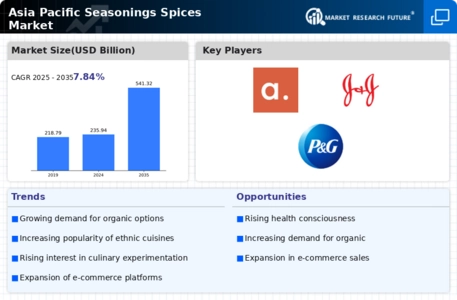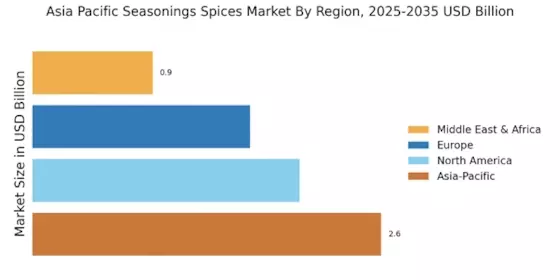E-commerce Expansion
The Asia Pacific Seasonings Spices Market is witnessing a rapid expansion of e-commerce platforms, which is transforming the way consumers purchase spices and seasonings. With the increasing penetration of the internet and mobile devices, online shopping has become a preferred channel for many consumers. Market analysis suggests that e-commerce sales in the seasonings and spices sector are expected to grow by over 15% annually, driven by convenience and a wider selection of products. This shift is prompting traditional retailers to enhance their online presence and adapt to changing consumer behaviors. As a result, companies are investing in digital marketing strategies to reach a broader audience, thereby increasing their market share in the competitive landscape.
Growing Food Service Sector
The Asia Pacific Seasonings Spices Market is benefiting from the expansion of the food service sector, which includes restaurants, cafes, and catering services. As dining out becomes more popular, there is an increasing demand for high-quality seasonings and spices that enhance the flavor of dishes. Market Research Future indicates that the food service industry in the Asia Pacific region is projected to grow at a rate of 7% annually, creating opportunities for spice manufacturers to supply their products to this burgeoning sector. This growth is likely to drive innovation in product offerings, as food service providers seek unique and diverse flavor profiles to attract customers. Consequently, the collaboration between spice manufacturers and food service operators is expected to strengthen, fostering a dynamic market environment.
Rising Health Consciousness
The Asia Pacific Seasonings Spices Market is experiencing a notable shift towards health-conscious consumer behavior. As individuals increasingly prioritize wellness, there is a growing demand for natural and organic seasonings and spices. This trend is reflected in the market, where the organic spices segment is projected to grow at a compound annual growth rate of approximately 8% over the next five years. Consumers are becoming more discerning, seeking products that not only enhance flavor but also offer health benefits. This shift is likely to drive innovation in product formulations, with manufacturers focusing on clean labels and transparency in sourcing. The emphasis on health and wellness is reshaping the competitive landscape, compelling companies to adapt their offerings to meet evolving consumer preferences.
Sustainability and Ethical Sourcing
The Asia Pacific Seasonings Spices Market is increasingly focusing on sustainability and ethical sourcing practices. Consumers are becoming more aware of the environmental and social impacts of their purchasing decisions, leading to a demand for sustainably sourced spices. This trend is prompting companies to adopt responsible sourcing practices, ensuring that their products are not only high-quality but also environmentally friendly. Market data indicates that the demand for sustainably sourced spices is expected to grow by approximately 10% over the next few years. This shift towards sustainability is likely to influence product development, with manufacturers exploring innovative packaging solutions and sustainable farming practices to appeal to eco-conscious consumers.
Culinary Diversity and Fusion Cuisine
The Asia Pacific Seasonings Spices Market is significantly influenced by the region's rich culinary diversity. As consumers become more adventurous in their cooking, there is an increasing interest in fusion cuisine that blends traditional flavors with contemporary cooking styles. This trend is evident in the rising popularity of ethnic cuisines, which has led to a surge in demand for unique spices and seasonings. Market data indicates that the demand for Asian spices, such as lemongrass and galangal, is on the rise, with a projected growth rate of 6% annually. This culinary exploration not only enhances the consumer experience but also encourages manufacturers to innovate and expand their product lines, catering to a broader audience seeking authentic and diverse flavor profiles.


















Leave a Comment